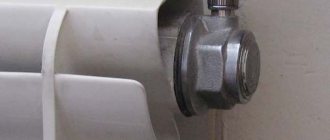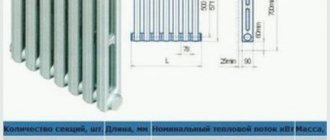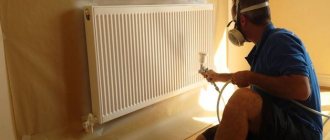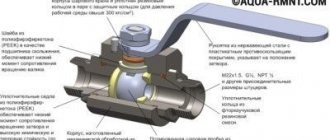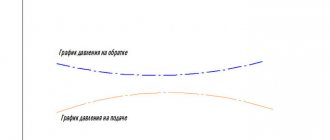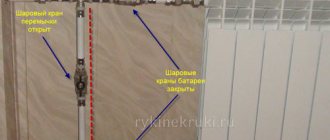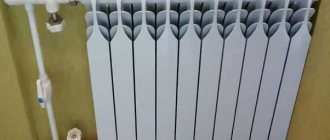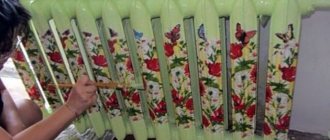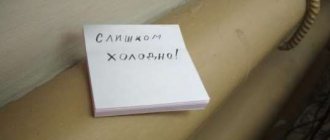Cast iron, despite its unsightly appearance, has one huge advantage over other materials used to make heating batteries - durability. Therefore, getting rid of used cast-iron heating radiators is a problem for every owner, despite major renovations of the entire home. After all, for decades they have been heating the apartment during the cold season, creating comfort and coziness for the people living in it.
In this case, it is worth tidying up the old batteries so that they can better perform their functions and try to change their appearance.
What is remarkable about cast iron batteries
Sectional cast iron batteries are installed, as a rule, in multi-storey buildings. Their positive properties are:
- corrosion resistance;
- low sensitivity to poor quality of supplied coolant;
- durability;
- affordability;
- functionality;
- thermal power;
- strength;
- thermal inertia.
However, they have a number of significant disadvantages:
- large mass;
- unattractiveness;
- roughness of the inner walls;
- the need for periodic painting.
But, despite the disadvantages, many owners do not want to get rid of old cast iron batteries. They are trying to restore them and bring them into proper condition, rightly believing that a “tested friend” is capable of serving honestly and reliably for many more years.
Don't make hasty conclusions
When solving any problem, you should never rush. This also applies to cast iron batteries. Of course, most technicians will advise replacing old radiators with more modern ones, but you shouldn’t rush. Such drastic methods need to be used only if the cast iron has cracked, or the battery has completely failed for some other reason and cannot be restored. In most cases, old cast iron radiators can always be updated.
In this case, quite a lot of questions arise:
- How to improve reliability?
- How to improve your appearance?
- How to fit it into the new interior?
- How to hide shut-off valves?
This list can probably be continued by anyone. Let's try to figure it out.
What can you do?
A cast iron battery must perform its functions to the maximum, the main of which is heating. Therefore, before restoration, some preventative work should be carried out.
Note! Before you start, you need to invite a plumber and be 100% sure that there is no water in the system. An important point is that prevention can only be carried out outside the heating season.
So, what is required:
- remove the battery and put plugs on the pipes;
- flush the interior of the radiator;
- change problematic seals, which are easily identified by red stains between sections or on plugs;
- install, if necessary, a Mayevsky valve, as well as shut-off valves and thermal heads.
It’s much more convenient to work with the battery removed, so there’s no getting around it when you overhaul it. The radiator is placed on a workbench or suitable table and the process of removing the old layers of paint that have been built up over the years begins. It is important to know that they significantly reduce heat transfer. Paint remover is unlikely to help with multi-layer coatings, so it is recommended to use a hair dryer and a narrow spatula. Rust and remaining pieces of paint are removed with a wire brush. In case of unwillingness or impossibility to remove the battery from its place, only the peeling paint is removed from the radiator, and the differences are carefully sanded until completely leveled.
Next is the old cast iron battery:
- treated with a rust converter;
- wipe with a damp cloth;
- degreased with a solvent;
- primed with a composition intended for metal surfaces;
- painted in any convenient way.
White color and oil paints are a thing of the past. In modern houses you can find radiators painted to match the color of the walls. Various metallics look good and give more warmth. The heating effect will create a bright orange or red color, and the ornament or airbrushing will make the radiator original and unique. The sections can be painted in different colors or a convex pattern can be made on their surface with an outline for stained glass, followed by varnishing.
The battery can be hidden behind a special screen, but it will certainly reduce the flow of heat. There are a lot of design options for heating appliances, and every home craftsman is sure to find something suitable for himself.
What can you do with old batteries?
There are only two options - repair and restoration or replacement. To understand which way to go, you need to conduct a complete and thorough inspection of the radiator. To do this, it is best to remove it from the mounts, having first disconnected it from the pipes. If it is not possible to unscrew the nuts, you will have to cut them off with a grinder. It is realistic to try to bring into working condition only a radiator that does not have cracks, dents, or through areas of corrosion.
If the radiator heats up unevenly, you can try flushing it
If during the heating season the battery warms up only in parts, it makes sense to try to wash it. To do this you can use:
- compressor;
- a regular water hose;
- rust removal products.
- A compressor hose or a regular water hose is connected to the hole in the upper part and water with chemicals dissolved in it is poured in. You can use “Mole”, caustic soda, or, if these are not available, use simple citric acid or vinegar essence.
- After pouring the solution, you need to give it time to react with the deposits inside the housing.
- The dirty water is drained and the battery is washed several times with water until the liquid coming out is clean.

Rinse until the water runs clear
It is best to carry out this procedure with the battery removed and outside. If this is not possible, the radiator should be taken to the bathroom.
Important! It is necessary to pour water into the battery after the chemical solution several times to completely wash it off. Otherwise, it will provoke the appearance of a new layer of rust.
Some experts recommend disassembling a cast iron battery into sections to make it easier to remove dirt from it. But such a procedure is not always possible due to several layers of paint and stuck fasteners. You can try to heat the structure with a blowtorch, on a stove burner, or in any other way. Such actions lead to expansion of the metal, burning out of the tow, and then it will be easier to unscrew the nuts. But it is important to remember that by applying excessive force or using an impact tool, you can damage the body, because cast iron is fragile. This also applies to tapping on joints.
After successful washing, you should think about tidying up the appearance of the heating device. For painting, you can choose any type of composition - acrylic, alkyd, oil, in a regular can or in the form of an aerosol. It is best to choose odorless paint, especially for residential premises; the substance should also be heat-resistant.

By painting you can give an old battery a modern look
An obligatory step is surface preparation. To do this you need:
- remove the old decorative coating or at least thoroughly clean the areas where the coating is cracked, swollen or missing altogether. There are several ways to remove old paint from radiators: you can use a grinding wheel, a stiff wire brush or chemical solvents;
- clean the surface from dust, treat it with a corrosion-preventing agent;
- apply a primer to the metal (if necessary);
- start painting. The composition can be applied with a brush, roller or spray bottle.
Note! Not every battery is suitable for chemistry. Some alloys may be damaged by it after the paint has dissolved.
It is not necessary to re-coat the radiator with the same color as before. You can show your imagination and turn it into an exclusive piece of furniture. Cast iron structures of an unusual shade will look especially advantageous.
After the paint has dried, you can start installing new Mayevsky taps on the radiators (screw them in instead of the foot nuts on one side, if they were not provided). Such an element is necessary to bleed air from the battery sections. If this is not done, air pockets inside will interfere with the uniform distribution of the coolant among the sections, as a result of which the battery will not heat well, and the empty areas will simply rust and accumulate debris.
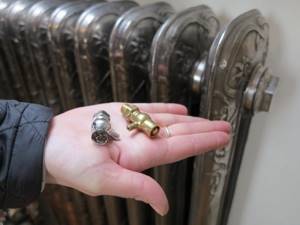
Mayevsky valves are necessary for releasing air from the radiator and draining the coolant
After this, you can begin installing the radiator in place. All connection points should be well sealed and all gaskets should be completely replaced so that there are no leaks when the fluid is supplied.
If you don’t want to bother with painting the battery, you can simply purchase a screen for it. Such a metal, wooden or plastic decorative element is quite easy to buy in a store or make with your own hands.
History of cast iron radiators
Cold has always been associated with discomfort and has caused trouble for people since ancient times. At that distant time, they tried to warm themselves by the fire, insulating themselves and their homes with skins. As centuries passed, stoves and fireplaces began to appear, and ducts were installed in houses through which hot air moved to other rooms. But this solved the heating problem only partially. A positive result was achieved when a water heating system was invented and radiators appeared.
It is known that more than two thousand years ago in Ancient Rome there was a system that was in many ways similar to modern water heating of houses. If we take a later period, then we can say with confidence that at the end of the 17th century, with the help of a liquid coolant moving along special coils, air in greenhouses and conservatories was heated in Europe. But this method was ineffective. Water heating appeared in residential premises only in the first half of the 19th century.
Note! The prototype of a cast iron radiator first appeared in St. Petersburg, where the first cast iron heating device was cast in the workshop of the Russian entrepreneur, inventor and manufacturer Franz San Galli. This happened in 1855.
The invention was called “Heitskörper”, which in translation sounds like “hot box”, and externally the battery only vaguely resembled a modern cast-iron radiator. Its design consisted of several thick pipes and vertical disks. Within a short time, the new product gained popularity not only in Russia, but also in countries where they know firsthand what the cold season is.
Encouraged by the success, San Galli began to think about how to give the battery a more attractive appearance, so he began to open new foundries one after another. Radiators began to be used in systems not only of water, but also of steam heating. The models were decorated with patterns and ornaments. The structures were bulky, but could withstand pressure of several atmospheres. By the way, in Tsarskoye Selo there is the oldest cast-iron battery, which is more than a hundred years old. The year of her birth is 1896! Not only has it been preserved in excellent condition, but it is still functioning.
At the end of the 19th and beginning of the 20th century, cast iron radiators began to be produced in Europe, mainly in Germany. In the German city of Weizler there is a museum, the exhibition of which contains many heating devices of that time.
It should be noted that in Samara, at the entrance of the local state district power station, there is a monument to a cast-iron battery, erected in 2005 to mark the 150th anniversary of its invention. This composition brings together two guardians of home comfort - the radiator itself and the cat lying on the windowsill located above.
Heating batteries - photos and videos of different types
Heating a private home » Heating radiators
Unusual battery shape
Modern companies producing heating devices offer a wide range of them, trying to please consumers not only in terms of technical characteristics, but also in terms of external data. Shape, size, color design play a very important role today, especially if the consumer dreams of an exclusive product. You can choose a variety of options for heating radiators - photos can be easily found in the designers’ portfolios.
Types of heating radiators
When choosing a device, its effectiveness is of paramount importance, not external data. Which heating battery is better? To understand this, you need to understand the existing types, and also consider their pros and cons.
Cast iron
We inherited this type of radiator from our grandfathers, but we still use it. True, these devices have ceased to satisfy modern consumers for three main reasons:
- Cast iron is a material with low thermal conductivity. For example, in order for the battery to heat up to +45 C, the coolant temperature must be +70 C. Hence the high fuel costs.
- This type of heating device does not last forever, although it has a fairly long service life.
- The appearance of cast iron batteries leaves much to be desired. Such devices are difficult to fit into a modern interior. Of course, they can be veiled by installing decorative panels or grilles, but this is not always the solution.
Despite this, manufacturers have not stopped producing cast iron appliances because they are still very popular. True, today these are no longer the same batteries, since designers have worked on their appearance, making them more stylish.
As for the advantages, we note one thing, but it is very important. This device is not demanding on coolant. He doesn’t care what kind of water flows in the heating system - purified or not at all, rusty or full of bacteria. Cast iron will withstand anything. In addition, such radiators can be installed in any room.
Aluminum
If you look at the photo of aluminum heating radiators, you will immediately understand that in terms of their appearance they are much better than their cast iron counterparts. Manufacturers are constantly offering new products, thereby increasing the model range, which is already wide. That is why there are a lot of different aluminum batteries on the modern heating equipment market, differing in appearance, design and price.
An indisputable advantage of the device is its high thermal conductivity. True, there are also disadvantages. For all its stylishness, aluminum equipment is very sensitive to the purity of the coolant. A little contamination and this work of art will immediately fail. So before purchasing aluminum radiators, you need to take care of the coolant purification system - installing filters and other devices, which will increase the cost of the entire heating system.
Another disadvantage is the high pressure ratio of aluminum. It is not recommended to install such devices in industrial premises with high pressure of hot water in the network - the device will simply burst.
Steel
Steel radiators have proven themselves well in the market
Steel heating radiators are divided into two subtypes - tubular and panel. The latter are classified as budget, and they have a high heat transfer rate. The panel option is unpretentious, so it can be used in any premises - residential, office and industrial.
But tubular analogues should be classified as “premium”. And the point here is not only in the excellent technical characteristics - high heat transfer and long service life, reaching 25 years. Excellent external data, which designers are constantly working on, also matters.
With the help of steel appliances, you can not only create warmth inside the rooms, but also decorate them. And if we consider pipe options from the entire line of steel radiators, then stainless steel batteries should be especially noted.
Bimetallic devices
We can only speak about this type of radiator in excellent terms. After all, bimetallic radiators have the highest technical characteristics:
- high heat transfer due to the presence of aluminum plates in the design
- durability and long service life due to the equipment of the devices with metal pipes
However, like any high-quality product, these radiators have a very high price.
How to choose the right model
Bimetal under the window
Looking at the photographs of heating radiators posted on this page, you can only evaluate their appearance. Visually you can’t determine their quality in any way. At the same time, the external side of the matter is a choice in terms of beauty and aesthetics. But it is much more important to know the technical characteristics of the products.
When choosing heating radiators, first of all you need to pay attention to their service life. This indicator depends on the quality of the product and its operating conditions. If we are talking about apartment buildings with central heating, then the quality of the coolant in this case is in great doubt. Hot water flows through steel pipes, so rust, scale and other debris are common in it.
Therefore, it is not recommended to install aluminum batteries in apartments. True, manufacturers began to use protective technologies and treat the internal surfaces of the device with polymer materials. This is the best option, but expensive.
Steel and bimetallic analogues are also susceptible to corrosion, but to a lesser extent than aluminum ones. What remains? Cast iron heating devices, which in this regard turn out to be the most reliable.
There is one more indicator that you should always pay attention to when choosing - this is the ability to withstand a certain coolant pressure. The minimum indicator is 7.0 atmospheres, but experts advise choosing a product with 15 atmospheres - in case a water hammer occurs in the system.
Attention! Today, many consumers pay attention to the design of radiators. And this is correct, because you cannot forbid living beautifully. But keep in mind that beauty should not come at the expense of quality.
Conclusion on the topic
Comfort in a house with a heating radiator
So, heating batteries, photos of which you can find in large quantities on the Internet and on our website, must be chosen correctly. Many consumers still believe that old cast iron radiators deserve their presence in our homes and apartments. But remember that they have been serving us for a long time, and all their service life has expired. Therefore, we recommend that you pay attention to modern cast iron appliances. They are distinguished by very high quality combined with interesting design solutions.
Related Posts
Comments and reviews on the material
gidotopleniya.ru
Modern tendencies
It would seem that no one needs outdated cast iron batteries. But it turns out that they are experiencing their rebirth! Retro and steampunk styles are now in fashion, the attributes of which are steam engines, telegraphs, gas lamps, tailcoats, hoods, tarpaulin boots, factory chimneys and accessories from the Victorian era.
Some European and American manufacturers have even begun to produce 19th-century style cast iron radiators, distinguished by artistic casting, and corresponding shut-off valves. Externally, the models can easily compete with antique batteries - they are aesthetically pleasing and quite expensive.
gidotopleniya.ru
Cast iron radiators - which are better?
Until now, cast iron heating radiators of Russian and foreign origin are most in demand among Russians. Why there is such a demand for them and which cast iron batteries are best installed in apartment buildings and private buildings – let’s take a closer look.
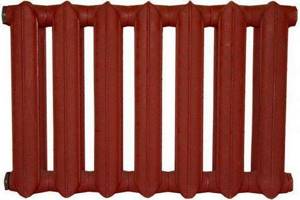
Cast iron battery made in Russia
In the West, heating systems are cleaner and of higher quality. Accordingly, cast iron batteries of a new type (the price is quite affordable) are designed with higher quality components of heating systems in mind. And Russian central heating systems often consist of low-quality components. For example, heating pipes quite often continue to be used even after several malfunctions: leaks, etc. This especially applies to sun loungers and risers.

Leaking cast iron battery
In the water used in such systems, there are pieces of rust and a considerable amount of chemical compounds deposited inside, and as a result, they can adversely affect the functioning of the batteries. Dirt that accumulates inside heating devices limits the internal clearance and the volume of water flowing through the radiator decreases, heat transfer decreases and as a result it stops heating. In addition, most of our population lives in high-rise buildings, where high pressure is used - from 10 to 15 atm. So, both old and new cast iron batteries turned out to be perfectly adapted for such operating conditions. Each section of the cast iron radiator has approximately 1.6 kW.
Old style cast iron radiator New style cast iron radiators
A rather unpleasant disadvantage of cast iron radiators is their considerable weight. So, the weight of one section of a cast iron battery is approximately 7 kg, and if there are deposits inside, then even more. Batteries also burst due to frost - their weight is maximum, since there is ice inside them. And therefore, it can be difficult to remove an old cast-iron battery from the room. In other words, 8 sections weigh 56 kg, and 16 weigh as much as 112 kg. They are so heavy because, due to the fragility of the material, their walls need to be made thick. And when installing a cast iron battery, you have to use more reliable fasteners than for aluminum and bimetal. Thus, only specialists can replace cast iron batteries.
Imported cast iron battery
Due to the unpretentiousness of old-style cast iron batteries in operation (paint them and forget about their existence), the use of such radiators is not only more appropriate, but is also a good option for a central heating system.
Of course, new cast-iron batteries, the price of which is affordable for the average buyer, look much more attractive than old-fashioned radiators, but the “oldies” have not lost their popularity and will fit well into multi-storey buildings of the Soviet type, as well as into private residential buildings. Or there is an alternative - you can use a decorative screen to hide their unsightly design.
Retro cast iron batteries
For both apartment buildings and private ones, another type of battery can be used - exclusive retro cast iron radiators, which are made using artistic casting, as well as heating devices of a new type.
If you choose the best cast iron radiators depending on quality, then, undoubtedly, imported models will be more practical and durable than domestic ones. But the cost of Russian-made cast iron batteries is correspondingly less than that of foreign ones.
In addition, there are many advertisements on the RuNet under the category “used cast iron batteries for sale.” Therefore, you can even buy cast iron radiators for pennies, which cannot be said about batteries made from other materials.
Cast iron batteries have no equal!
The installation of a cast iron battery on heating systems with natural water circulation is still relevant. In addition, today it has been proven that heat from such batteries is more beneficial than from other types of radiators.
And it is important that manufacturers are now paying more attention to external batteries. Therefore, you can choose a stylish cast iron radiator that will fit perfectly into the interior of your heated room. That is, old or new cast iron batteries, imported or domestic - it’s whatever your heart desires!
remontspravka.com
What parameters should you use to choose radiators for an apartment?
Now, knowing the weak points of central heating, you can already imagine what requirements good batteries must meet. Let's list them.
1. For radiators, the pressure declared by the manufacturer must exceed the pressure (both the working pressure and one and a half times the test pressure) in the heating system. Let's look at the numbers as an example. In five-story buildings with an old layout, this parameter is no more than 5 - 8 atmospheres. Modern multi-storey buildings are heated under pressure of up to 12 - 15 atmospheres.
2. Separately, we note the ability to resist water hammer. Because when living in an apartment, it is difficult to protect yourself from pressure surges in the heating; it is better to prevent trouble in advance. By the way, if you often hear humming and clicking noises from your batteries, contact your utility service. The pressure seems to be playing tricks in the system.
3. The quality of water in the domestic heating system is unimportant, so the batteries must withstand its “chemical attack” with honor without collapsing. It is necessary to use radiators with a special coating on the inside or chemically neutral material for the walls
And their thickness must be such that particles of sand and small pebbles do not rub it, acting like emery.
4. When deciding which radiators are best for an apartment, let’s not forget about their main function - to heat. That is, it is preferable to choose devices that have greater heat transfer.
5. Let’s not ignore the design of radiators - few people are satisfied with the ugly, poorly shaped cast-iron monsters that stood everywhere in Soviet times. I would like the radiators to harmoniously complement the decoration of the rooms - today this is quite possible
6. The last parameter is the duration of service. No comments are needed here. The less often you have to bother with installing these bulky and rather expensive devices, the more profitable it is for the owners.
Features of manufacturing batteries from cast iron
For too long, cast iron radiators were the only type of heating device installed in apartment buildings. Many people are so accustomed to them, knowing about their durability and reliability, that when the time comes to change the heating system, they look for similar devices.
The cast-iron batteries of the new model are completely different from what the residents of Khrushchev-era apartment buildings are used to. Old models had their advantages, against the background of which their shortcomings were forgotten, and this is due to the peculiarity of their manufacture.
This metal cannot be processed, so products made from it, be it old cast-iron heating radiators or frying pans, have always been cast in ready-made molds. This is due to the fact that for many decades sectional “accordions” of the same height, width and depth were produced.
To change the thermal power of a cast iron radiator, it was necessary to add or remove a section, for which the coolant was completely drained from the system, paralyzing the heat supply to the building.
To ensure high-quality sealing, rubber gaskets are installed between the sections (if antifreeze is used, they must be paronite).
Cast iron sectional radiators are connected using nipple nuts and a special wrench and are divided by type:
- For single-channel samples, which are found mainly in vertical models.
- Double-channel types are the main type of cast iron radiators.
- Three-channel ones are extremely rare; they have the highest heat transfer and great depth.
According to the shape of the collectors, types of cast iron heating radiators can be divided into oval and round. The former are recognized as more reliable and resistant to water hammer, but the thickness of the walls of the device is no less important. To make them as light as steel or bimetallic radiators would require thin walls, but they are too vulnerable to shock and mechanical damage. A layer of cast iron that is too thick will make the radiator invulnerable, but unliftable, which is also unacceptable, and it will also take forever to heat up. Old radiators weighed about 7.5 - 8 kg, which is quite a lot for one section.
In Soviet times, several types of blanks differing in size were used for their production. The depth depended on the number of channels for the coolant, and the height depended on the interaxial distance.
There were different models with center-to-center dimensions from 300 mm to 900 mm, but the most popular was the distance of 500 mm, which in our time is considered the classic standard for radiators made of any metal.
If you are replacing old cast iron batteries with new ones, you should choose analogues with the same center distance, which will ensure the reliability of their connection to the heating system and operational efficiency.
The parameters of these radiators were such that they were fully consistent with the centralized heating of those years:
- Working pressure 9 – 12 atmospheres.
- Heating of the coolant up to +110 degrees.
- Resistance to chemical impurities in water.
- Operational life is 20 years with perfect operation up to 50.
- Low cost.
The biggest disadvantage of Soviet “accordions” was their weight. They were difficult to transport and install, and not every wall can withstand such a “burden.” With the advent of high-rise buildings, the strengths of cast iron radiators no longer meet the new standards of centralized heating, since in buildings with more than 12 floors the water hammer is much higher than they can withstand.
#1 Battery painting
The design of radiators painted in the same tone as the walls looks stylish and solid if the room is made in a deep and rich color. And in a small room without windows, a bright radiator spot can be a good accent, distracting from various shortcomings of the room.
#01 is a rainbow, not an LGBT flag. There is no, once again NO, blue color on the LGBT flag! All colors except blue.
But the primary task of the radiator is to heat the room, so the layer of paint applied should be small. First, all preliminary layers are removed. The battery needs to be polished to a shine for better adhesion of the metal to the paint. To do this, the old coating is first scraped off with a knife and then sanded with sandpaper. Next, a degreaser and primer are applied with a brush, carefully going through all the cavities and bends.
#02
Remember! The better the surface is cleaned and the more thoroughly the primer is applied, the better and more durable the paint will be.
#03
Paint it in the summer when it is cold, otherwise the paint may change color or even crack
The most crucial moment is to apply the main color to the battery yourself. Anti-corrosion paints are chosen for painting. The jar or can must indicate that the paint can withstand surface heating up to a temperature of 80 °C, that is, they are approved for use in heating appliances. European companies produce paints that can withstand heating up to 160 °C. You can also purchase special enamel marked “for radiators.”
#04
To paint batteries use:
- • quick-drying water-based paint that does not have a strong odor and does not change color when heated;
- • acrylic enamel, applied without primer, adding gloss and maintaining a fresh look for a long time;
- • alkyd enamel, which protects the surface well and does not change the structure when heated.
#05
Before processing batteries and painting them, you need to lay any protective covering on the floor: old newspapers or cellophane film. You can also cover the wall behind the radiator so as not to stain the pasted wallpaper. The choice of color is the prerogative of the owner. Whatever advice fashionable home designers give, you should choose the decor that will be pleasant to see every day. Whether the radiators are plain or any color of the rainbow. Examples of such homemade heating radiator decor can be seen in the photo.
New batteries
Modern types of cast iron batteries are not at all similar to their old “brothers”. Over the last 15 years, steel and aluminum radiators have become very popular, but the former are mainly represented by panel-type models, which do not fit into every heating system, and the latter cannot withstand the chemical effects of the coolant of the city heating network. That is why many consumers have turned their attention to the varieties of cast iron heating radiators of the new generation. Their positive qualities:
- Externally, they are not much different from modern analogues made from other metals. Sections with a flat, smooth surface will fit into any interior. On sale there are not only products with factory paint, but also those that can be painted independently in any color (domestic production), which many customers like.
- The cost of new cast iron batteries is still low, which makes them attractive in the eyes of consumers.
- They have higher heat transfer due to reduced volume.
- Their weight has dropped significantly. If the old samples weighed from 8 kg and above, then the new ones - from 3.5 kg and a maximum of 7.1 kg per section.
- Today there are decorative cast iron radiators in retro style, as well as floor-standing, vertical and classic models.
The fact that batteries of this type have become lighter and more stylish, while maintaining their main positive aspects, makes them very popular among the population.
What were old heating batteries made from?
The “warmest” household batteries are considered to be cast iron - they are also called accordions. Despite their heavy weight and difficulties in building up sections, they are still very popular today because they are characterized by high heat transfer. Modern production even offers “antique” models - on legs, with decorative elements painted “bronze” or “silver”. In many homes they continue to be used and even sometimes cope with their task quite successfully. They are easy to care for; their body can be easily cleaned of dust and washed.
Steel models were produced in several variations - either panel type or plate type. In terms of heat transfer, they are much inferior to cast iron, so the owners are trying to replace them with modern ones. In addition, getting rid of dust that accumulates between the plates is a difficult task, since the gaps between them are small. Sometimes even a powerful vacuum cleaner is powerless.

Cast iron batteries give off heat better than all others
Steel batteries are susceptible to rusting; very quickly this process begins to occur inside the structure, since there is no protective layer.
Over time, both cast iron and steel radiators become clogged with debris that is present in the coolant, and this leads to its uneven distribution inside the housing. As a result, part of the battery heats up, while part remains cold.
Decorative radiators made of cast iron
On the domestic market, artistic types of heating devices are represented mainly by foreign manufacturers. As a rule, these are designer works that not only weigh slightly more than their classic “brothers,” but also cost several times more. Such luxury can be installed exclusively in the interior that matches it.
Decorative cast iron heating radiators are presented in the Baroque and Renaissance styles, Art Nouveau and Neoclassicism. The style and ornament of a product do not affect its cost, unlike size and shape. So among them there are low batteries, a standard height of 500 mm or high types. If the interior requires “antique” heaters, then preference is most often given to models with a patterned design. Their colors can be completely different and they look not only impressive, but also expensive.
As a rule, decorative radiators made of cast iron have the same properties as modest classic examples. The sections are mounted in the same way as the usual Soviet “accordions”. Cast iron batteries with legs look especially stylish and unusual.
Is it worth repairing batteries at all?
Repairing old heating radiators is justified when their technical characteristics fully correspond to the area of the room and other parameters, and the problem with heat transfer is associated with the presence of deposits inside the housing. Both washing and painting are quite labor-intensive jobs, especially if the device weighs a lot. At the same time, if the battery functions are successfully restored, you can save significantly on the purchase of a new one, and if we are talking about several devices, the amount is significant.

The restored cast iron battery looks stylish and expensive
It makes sense to “fight” for cast iron varieties, since they are among the best in terms of heat transfer and not all modern models can compete with them. Moreover, replacing them with a version made of the same material will cost more than bimetal or aluminum.
In any case, it is worth calculating the costs of repairs and comparing them with the prices of new models in order to understand whether it is profitable or not.
Note! Modern batteries (especially original designs) may require the use of additional adapters for connection to used pipes, and this must be taken into account when planning work.
An old battery is not always the same as a used one. In many cases, such a structure can be put in order using the simplest means. Of course, you will have to spend time and effort, but in order to save money, it is worth doing. And you can throw away or sell for scrap the old-style radiator at any time, having prepared a worthy replacement.
Source
Floor cast iron batteries
This type of radiator appeared out of necessity. Cast iron is a fairly heavy metal, from which any product “inherits” considerable weight, and batteries are no exception. Not every wall can withstand such a load, so the manufacturers met their customers halfway by launching a cast iron floor radiator into production.
Also, panoramic windows, which have been very popular lately, require a different approach to heaters. Low floor models look good and at the same time have all the advantages of their taller counterparts. Today, floor-mounted cast iron heating radiators are considered elite, so their cost is one of the highest among batteries made of this metal.
The advantages of these devices are:
- Stability is ensured by strong legs that can be screwed to the floor if necessary.
- They take up little space, and when installed, the pipes are laid on the floor, which improves the visual appearance of the room.
- Floor batteries can be of any color.
- They perform well in closed heating systems.
- Installing a floor structure frees owners from work such as drilling walls and attaching brackets.
In terms of their technical indicators, radiators of this type are not much different from standard cast iron models.
Plate heating radiators
When arranging a home with a heating system, it is necessary to pay special attention to heating devices, in particular radiators. The level of heating of the room largely depends on them. Among the variety of such elements, I would like to mention thin radiators. They are much lighter in weight than cast iron heat exchangers, which makes their installation process easier and more convenient.
- Design characteristics
- Is it possible to install thin radiators in an apartment?
- Equipment
- How to properly install and operate narrow heat exchangers?
- Popular models
Features of vertical radiators
Tall radiators are rare and are quite expensive, regardless of what metal they are made of . Considering the weight of cast iron, vertical radiators made of it cannot be the same size as, for example, aluminum or bimetallic, which can reach 3 m. The maximum height that vertical cast iron heating radiators have is 1 meter.
As a rule, they are represented by sectional tubular structures, which, although they take a long time to heat up, retain heat and cool down for the same long time. Such models have high heat transfer, despite the large volume of coolant in them . Their main disadvantage is their weight, which significantly exceeds standard analogues not only due to the greater height of the sections, but also the thickness of the walls.
Which radiators to choose for an apartment?
So which heating batteries are best to choose for an apartment? Which product will provide enough heat and last a long time? Here you can choose from two options:
Cast iron batteries. They easily tolerate deficiencies in the quality of the coolant in central heating networks. In addition, cast iron products are not afraid of pressure changes. Also a big plus is low cost and long service life.
Bimetallic radiators. This is a good alternative to cast iron products. They have similar characteristics, but bimetallic batteries are more aesthetically pleasing.
Of course, if you have enough funds, you can install copper batteries. Such devices will work almost forever and heat the apartment perfectly.
The aluminum and steel option is more suitable for an autonomous system. In this case, the owner himself will monitor the quality of the coolant and prevent foreign impurities from entering it. Also, the pressure in autonomous systems is much less.
Heating elements for cast iron batteries
It is not surprising that today many consumers are looking for alternative types of heating their homes. The cost of utilities is constantly rising, which cannot but cause concern. One of the ways to create autonomous heating in an apartment is a cast-iron battery with a heating element for heating.
A heating element is an ordinary metal tube with a spiral located inside it, which is separated from it using a filler. You can make it yourself from available materials. Batteries with heating elements are distinguished by high performance, economy and reliability, and the fact that they are built into the heating system itself allows you to save space and ensure their unnoticeable presence.
Such a device can be equipped with a thermostat to regulate the degree of heating of the coolant and serve as both an additional and the main source of heat.
There are heating elements of different power on the market, so you should make calculations in advance of how many watts will be required per radiator section to heat each individual room.
How to beautifully fit cast iron batteries into the interior?
It is not always possible to replace old batteries with new ones. Often, cast iron batteries do not fit into a modern interior and spoil the overall appearance of the apartment. How to beautifully fit them into the interior? We know the answer to this question!
- Hide the battery. Now there are a lot of different beautiful boxes or, as they are called, screens that will hide batteries. The advantage of the weight is that this screen can be matched to your interior, and the battery will remain invisible. By the way, the box can also be used as a shelf by placing the necessary things on top.
- The battery is the main decoration of the room. Let's return a little to the previous point. You don't have to buy a box, you can make it yourself! To do this, take thick cardboard, paint it beautifully and install it on the battery, completely hiding it. The design can be anything, but it will definitely attract the attention of others.
- Table. If the battery is well located and it is possible to replace it with a table, then this option is definitely for you. We put a table or beautiful shelves above the battery, or you can use two options at once, paint the battery to match the color and voila, the battery is almost invisible!
Any item can be decorated and made unique! Imagine and your apartment will become modern, cozy and practical!
Nature manages its resources rationally, and each of its components lives several lives - the same maple leaf first serves as a tree’s “breathing” organ, processing carbon dioxide with the help of sunlight into oxygen, and then, when its resource has been used up, it turns into food for the same wood and bacteria. Only man in nature, despite his rationality, acts irrationally, throwing into the trash everything that becomes unnecessary to him. Yes, nature will eventually eat this garbage, but from a human point of view, such an act still remains an irrational act, and this applies to literally everything created by man. Old batteries are no exception, which, at best, are sold for scrap - in principle, this is the right decision, but not the only one. In this article, together with the website, we will talk about how to deal more rationally with outdated cast-iron heating radiators.
Old style cast iron batteries photo
Old batteries: a second life for their intended purpose
What makes old cast-iron batteries attractive is their, dare I say it, enormous service life - these are practically eternal batteries that cannot be demolished. Judge for yourself - today in houses and apartments you can still find working batteries installed under Stalin. Is it a joke? Almost a century old batteries. Radiators made before the collapse of the USSR have almost the same quality - at least they can still work for half a century for their intended purpose.
I agree that by modern standards they are ugly and inconvenient to maintain, but who will stop you from bringing them into divine form and enjoying the warmth they emit for the rest of your days? This is very easy to do, and it is this fact that many restorers use, buying old batteries for cheap, bringing them into proper shape and selling them at a much higher price, thereby earning a living. To be specific, this work looks like this.
- First, the inside of the batteries is washed using chemicals that remove all contaminants from the batteries, including rust.
- Then the battery is disassembled into sections. This is perhaps the most difficult stage of the work - in order to unscrew the old threaded nipples connecting the sections, you need to resort to high heat. The heated metal expands and releases the nipple a little - at this moment the batteries need to be disassembled.
- And then mechanical cleaning - sandblasting, after which the old heating radiators become new. No paint, no rust, no scale - just pure metal with its characteristic shine.
After this, the creative process begins, thanks to which it is possible to give the sections a unique and inimitable look. Even simply painting them with the same hammer paints will make old batteries very attractive. People who are familiar with the benefits of old cast iron batteries will pick them up with their hands and feet.
Repair of heating radiators: process features and sequence of actions
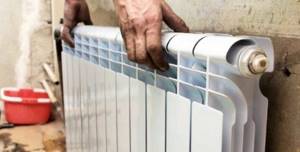
Repairing heating radiators is a rather unpleasant and difficult task. In addition, this process is expensive if you pay for the work of professionals. Therefore, to avoid costs, you can do it yourself. To do this, you should follow the sequence of actions, and also have the necessary tools and materials in the house.
Old-style batteries: what else can be made from them
Restoration for the purpose of resale or simply selling old-style cast iron batteries for scrap metal is not the only option for the rational use of this element of the heating system. You can use it to make useful things not only for sale, but also for your own needs.
- The first thing that comes to mind is electric heaters - mobile or stationary. Making them from an old battery can be said to be quite simple - for this, in addition to the cast-iron battery itself, you only need a couple of things. A heating element with a thermostat (such as is used in water heating tanks), a piece of cable with a cross-section of 2.5 squares and a plug into a socket. Assembly is simple - the heating element is screwed in instead of one of the foot nuts at the bottom of the battery (the thread fits perfectly) - connect the cable and insert the plug into the socket, having first filled the battery with water. Alternatively, you can fill it with both oil and antifreeze. In addition, it would not be superfluous to take care of air venting - you need to screw a Mayevsky valve into one of the upper foot nuts.
- If you take a closer look at the heater described above, you can come to the conclusion that with minor modifications it can also be used as an electric boiler for a full-fledged small-sized heating system. The two remaining free connections (one on top of the battery and the other below) can be used as supply and return. This is a good option for a dacha, but you need to remember that any boiler needs a safety group, a circulation pump and an expansion tank - all of this will have to be installed yourself.
In addition, some craftsmen use old cast iron batteries as heat exchangers for solid fuel stoves. In my opinion, the idea is not very attractive - the cast iron sections will have to be welded together to get rid of the gaskets between them. Yes, and the heat exchanger will be bulky, which will cause some problems during its installation. There are already enough problems with old batteries, just take them apart, which will require a fair amount of tinkering.
stroisovety.org
Installation of plasterboard covering for radiators
So, we found out how to close the heating system, all that remains is to clarify how to properly install the plasterboard covering.
Using a plasterboard box.
Required materials and tools
During installation work you will need the following materials and tools:
- plasterboard sheets;
- sharp pencil;
- yardstick;
- screwdriver;
- metal scissors;
- self-tapping screws;
- building level;
- dowels;
- decorative lattice;
- profiles.
Installation technology
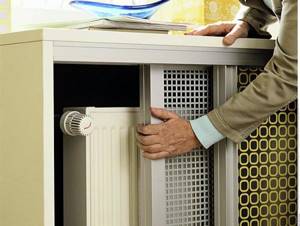
An original option for decorating radiators.
If the radiators of your heating system are located in a niche, then in order to hide them, you can install a profile frame that will correspond to the perimeter of the recess. By using a guide profile, which is attached to the bottom of the window sill, floor and walls using self-tapping screws, you can create a single frame. In order for the plasterboard wall to be installed level, you need to deepen the front edge of the frame by about 15 mm. Thus, the surface should coincide with the wall.
What are the benefits of cast iron batteries?
Cast iron batteries have been used for more than 160 years. During this time they have undergone some changes. The first sample was presented by a Russian entrepreneur who was also an engineer. This event took place in 1857. It would be difficult to identify such products by appearance based on modern batteries. Initially, the emitters were a cast iron pipe. Metal plates were located along the pipe, which increased thermal output. To start the process, it was necessary to fill the pipe container with hot water. The principle itself has not changed today.
The operating principle has remained unchanged to this day. Today, similar designs continue to be produced, but instead of a cast iron pipe, a steel pipe of smaller diameter is used. Modern cast iron batteries do not have metal plates, but have specially shaped ribs. If the products were not particularly effective, they would not have been used for so long. One of the main advantages due to which many people choose cast iron products is corrosion resistance. Thanks to the thick wall, as well as some features of the metal, cast iron products can last quite a long time.
This is very important in the case of centralized heating in the house. Often there are special impurities in water that accelerate the destruction of batteries. Even if the liquid is initially clean, before it gets into a particular home, it needs to pass through hundreds of meters of pipeline, which is not particularly clean. There are significant growths and deposits on the walls, which saturate the water not only with calcium, but also with other salts. Various abrasive substances can also come into batteries with liquid. Among the impurities there is also rust. All together this forms a powerful cocktail that is ready to destroy the metal.
Aluminum radiators are unable to last as long as cast iron ones. In some cases, they do not manage to survive even one heating season. If cast iron batteries are already in an apartment where there is central heating, then you should not replace them with new ones during renovation, as this may cost more. The main reason for replacement is the design, which does not correspond to the modern interior. With proper maintenance of cast iron products, they can last more than 50 years.
Cast iron batteries have another undeniable and so far unattainable advantage. This concerns their inertia. It is true that you have to spend a little more energy to heat them, but such batteries also take much longer to cool down. This is achieved due to the thick walls of the radiators themselves, as well as due to the large volume of circulating liquid. Cast iron radiators are easy to maintain. It is not difficult to choose paint for them, and there is also no particular difficulty in finding components. If they are missing, then a good turner can turn adapters yourself. And the gaskets are easy to cut from any suitable material.
How to rinse at home
In country houses, the heating system often loses its efficiency. This happens through poor heat transfer, as well as as a result of debris settling on the walls of the batteries. The coolant heated to a high temperature affects the inside of the radiators, where scale and rust settle. The presence of blockages leads to poor heating of the building.
The main reasons for flushing batteries are:
- Uneven heating of the radiator over the entire plane, when the upper part of the sections is hot, but the bottom of the tank remains cold;
- Warming up the heating system to the required temperature takes longer than usual;
- Increased fuel consumption.
To independently flush heating devices, aluminum or cast iron radiators, you need to drain the water and unscrew the radiator from the system. Removing blockages or flushing occurs using clean water with the addition of acetic acid, special cleaning agents or caustic soda.
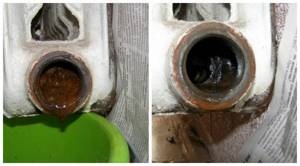
Battery before and after washing
It is advisable to carry out the work in the bathroom to prevent liquid from spilling onto the floor. At the same time, a mesh is installed in the bathroom drain hole to collect large contaminants. Pre-placed rags will help prevent damage to the container's coating.
At the initial stage of work in cast iron radiators, all plugs are unscrewed, and water heated to a boil is poured into the resulting holes. Next, shake out the heating device and drain the liquid and debris.
Next time, water with the selected cleaning agent is poured into the radiator. After this, close all the plugs, knock on the device with a wooden hammer, shake it and pour out the water. Similar operations are carried out until clean liquid flows from the holes.
What are the disadvantages
If cast iron batteries had only advantages, then they would be used everywhere, and no one would ever change them. Such products also have negative aspects that force users to abandon them. One of the big disadvantages is the complexity of installation. On the one hand, this is due to the weight of the structure. One rib has a mass of 6 kg. This means that under the window where the 12-fin radiator is located, 72 kg of weight is suspended, excluding water. Not everyone can lift such a miracle, let alone capture it. If the task arises of installing cast iron products on plasterboard walls, then you will have to get smart and install fasteners into the wall, because the sheathing will not support them. On the other hand, the process of connecting steel pipes can be a challenge for some.
In addition to weight, you also need to think about the space that cast iron products will occupy. Although the area under the windows can hardly be called useful, if the task is to recess them into the wall and install a grill, then this will become a real problem. In addition, in a small room, a radiator of this type does not look very harmonious. The large volume of liquid inside is not only a plus, but also a minus. The more water, the more energy has to be spent on heating it, so heating costs in a private house with such batteries will be significantly higher than with steel ones. Modern radiators are more efficient by heating air by convection. Due to the shape of the fins, it is passed through them and heated by the incoming flow.
If we talk about cast iron batteries, the situation with them is somewhat different. Only a fifth of the energy is spent on heating the air by convection, the rest of the power is spent on thermal radiation. This approach is significantly inferior to modern analogues due to the fact that in order to increase the heating power it is necessary to increase the size of the battery itself. Also, in individual heating systems where cast iron products are installed, it is almost impossible to use thermostats due to their high inertness.
Masking of radiators and the laws of heating engineering
The main task of any heating radiator is to heat the room. The goal is achieved by combining or separately using two methods - infrared radiation and convection. Thanks to them, comfortable conditions are formed. Infrared radiation transfers heat to objects in the room, while convective radiation heats the air.
We can feel thermal energy if we place our hand in close proximity to the radiator. Convection ensures air circulation and uniform temperature distribution throughout the room. This is known from school physics courses - warm air, rising upward, displaces colder air.
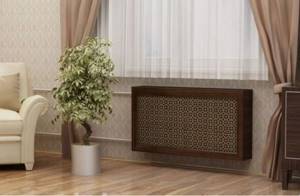
You need to understand that almost any method of hiding pipes and radiators will lead to an inevitable loss of heating power. The simplest example is the use of a glass screen with artistic painting.
It would seem that the task of decorating the radiator was completed successfully, but the room immediately became noticeably colder. This all happened because glass almost completely neutralizes infrared radiation.
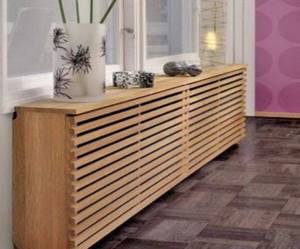
The deeper and more securely the radiator is hidden, the greater the losses will be.
This statement fully applies to blind screens that prevent both long-wave infrared radiation and short-wave convection.
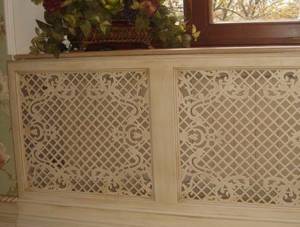
The same can be said about the blind boxes above the top of the radiator - they are an insurmountable barrier to the spread of warm air upward (the convection method does not work). The conclusion suggests itself - the larger the area of the holes in the lining, the smaller the heat loss will be.
This photo selection will present original ideas for decorating and camouflaging heating appliances:
Design features
Few people have moved away from the old scheme for assembling cast iron products. Batteries are made up of separate sections, and they can be:
- with one channel;
- with two channels;
- with three or four channels.
The first ones are not installed in residential premises due to their size. They are high altitude batteries. Often used in various workshops and other production facilities. The second type of cast iron products is the most common. These are the ones that are used in private houses and apartments. The third type has a larger area of liquid circulation, so the width of the batteries is slightly larger than that of two-channel ones. This also affects the wasted fuel to heat the fluid inside the batteries.
One of the features of cast iron batteries is the possibility of increasing or, conversely, reducing them. The individual ribs are connected via nipples, so they are easy to unscrew. There are gaskets at the joints. The latter can be made of special rubber or paronite. Water moves inside through round or elliptical channels. In most cases, paronite gaskets are more reliable. In the event of a small leak after a long period of inactivity, they can close the leak by swelling from exposure to liquid.
For domestic purposes, cast iron batteries are used, which have a height of 35–70 cm. The maximum height can reach 1.5 meters. The parameters are selected depending on the area that needs to be heated. With the maximum number of channels, the depth of the product can reach 1.4 meters. At home, products with a width of up to 20 cm are usually used.
Disadvantages of plate radiators (convectors)
- The convective type of radiators does not allow heating the room evenly. Radiators are warmer than the opposite wall of the room.
- The convector plates are an excellent dust collector. They are difficult to clean. Over time, dust reduces their heat transfer.
- The appearance of plate radiators is not encouraging, although there are nice models.
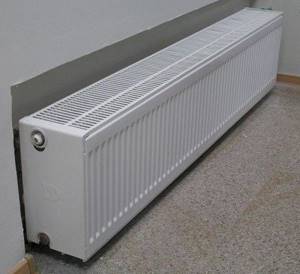
Varieties
Cast iron batteries differ not only in their overall dimensions, but also in their design features. Among them are:
- mounted;
- with supports.
Cast iron batteries that have a familiar appearance are almost impossible to buy new. Most of those available for sale have already been used. But in hardware stores you can purchase an updated version of cast iron batteries. In appearance, they are significantly different from those that existed before. You can compare them with aluminum or bimetallic options. The fins are made taking into account air heating using the convection method. An inexperienced buyer will not immediately distinguish them. The surface of such batteries does not have roughness or grooves. Casting is performed on top-class equipment, which also affects the quality. The principle of connecting individual sections remains.
If an apartment or house has many design solutions, then you can choose cast iron radiators for your home in the same style. Outwardly, they are more similar to the old designs of cast iron batteries, but casting is carried out in special molds, which also have special patterns and shapes. Such batteries can be made in a format with a support, i.e. there is no need to attach them to the wall, and the design already includes legs for installation. The color of such cast iron radiators can be selected depending on the designer’s ideas.
Heating efficiency and beauty: what to choose
The battery is not an interior decoration. In most cases, heating devices need to be masked.
In the current state of the construction and finishing market, there are no obstacles: choose, buy, install any “scenery”. But the owners are strongly convinced that any obstacle to the heat from the radiator will greatly reduce the temperature in the room, causing cold feet and increased utility bills.
Heating engineers reassure: with the correct installation of decorative elements on the heat source, the heating level can even be increased!
According to interior designers, the finishing of batteries is justified by the following factors:
- decorations can hide the age or defects of the heating system;
- “match” a plumbing part with the most sophisticated interior;
- will protect old, small (and four-legged) inhabitants of the house from burns;
- will protect the heating element itself from unwanted influence.
A nuance: awkward attempts by owners to decorate batteries themselves can lead to aggravation of the situation: air circulation is disrupted, aesthetic defects stick out. Contact the professionals. First, study in the photo how interior specialists cover batteries.
Radiator selection
The choice of radiator for a specific room will depend on its area. It is worth understanding that 100 W of heating device power will be consumed per 1 m2. This figure is valid for those rooms where the ceiling height does not exceed 2.5 meters. If we calculate according to this coefficient, it turns out that for 15 m2 of heated area you will need a radiator with a power of 1.5 kW. But this is under ideal conditions, so an additional reserve of 20 percent of power is made. This means that it is better to take a cast iron battery that is capable of delivering 1.8 kW. For standard cast iron batteries with a distance between the axes of 50 cm, this figure will be equal to 12 sections. A video about choosing a cast iron battery can be viewed below.
bouw.ru
